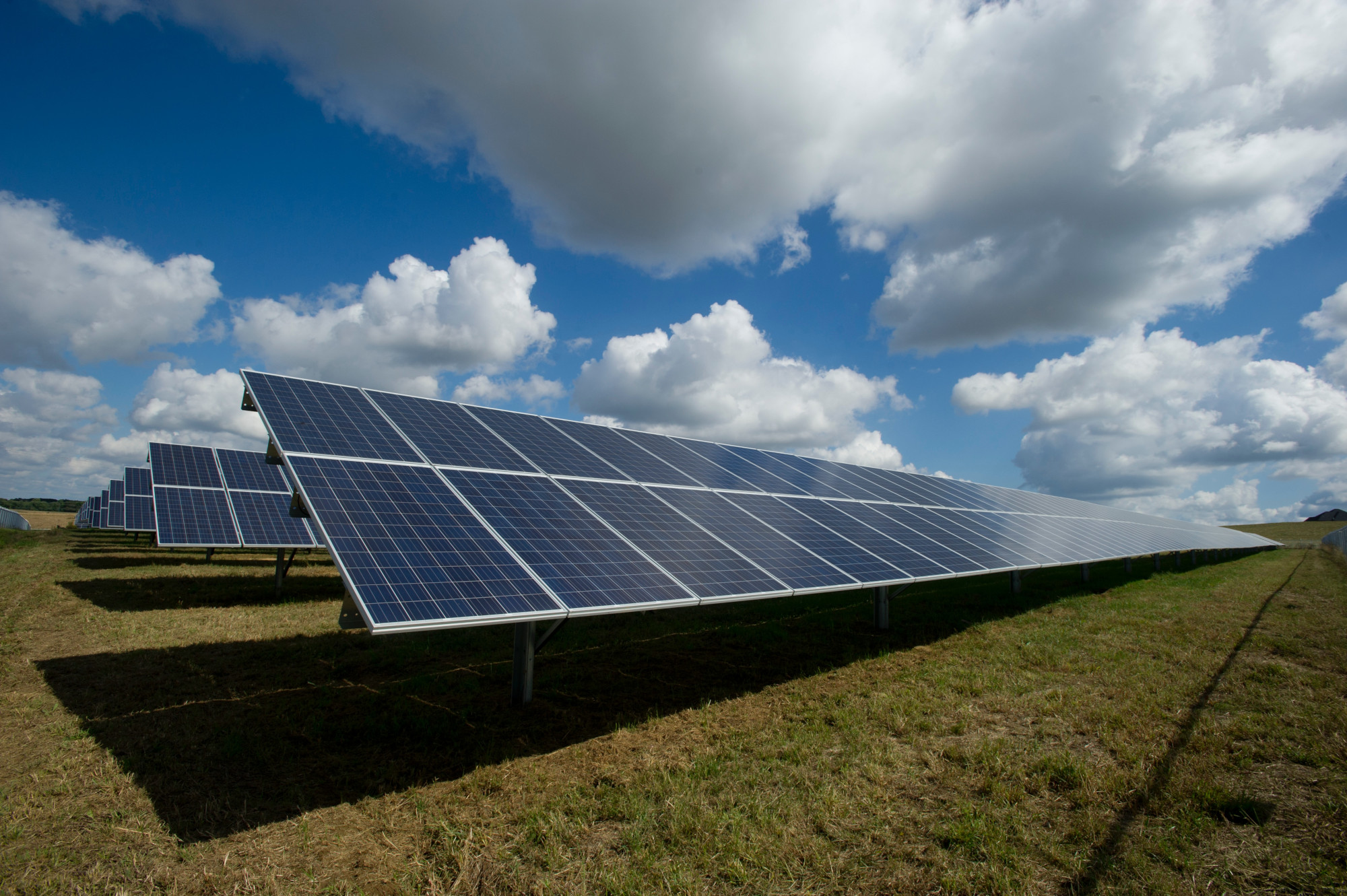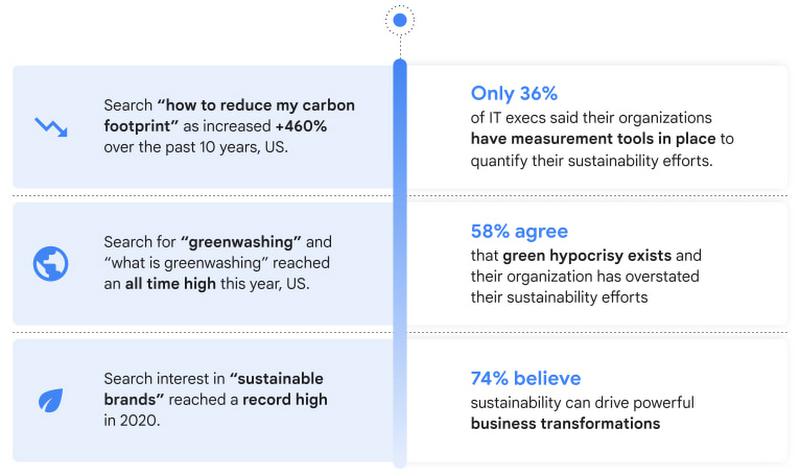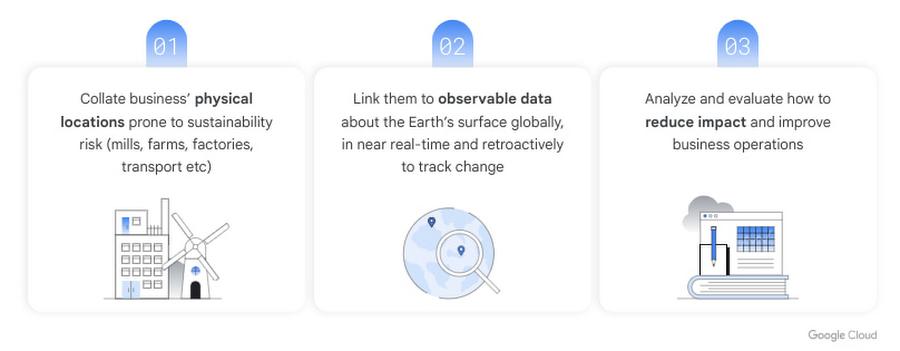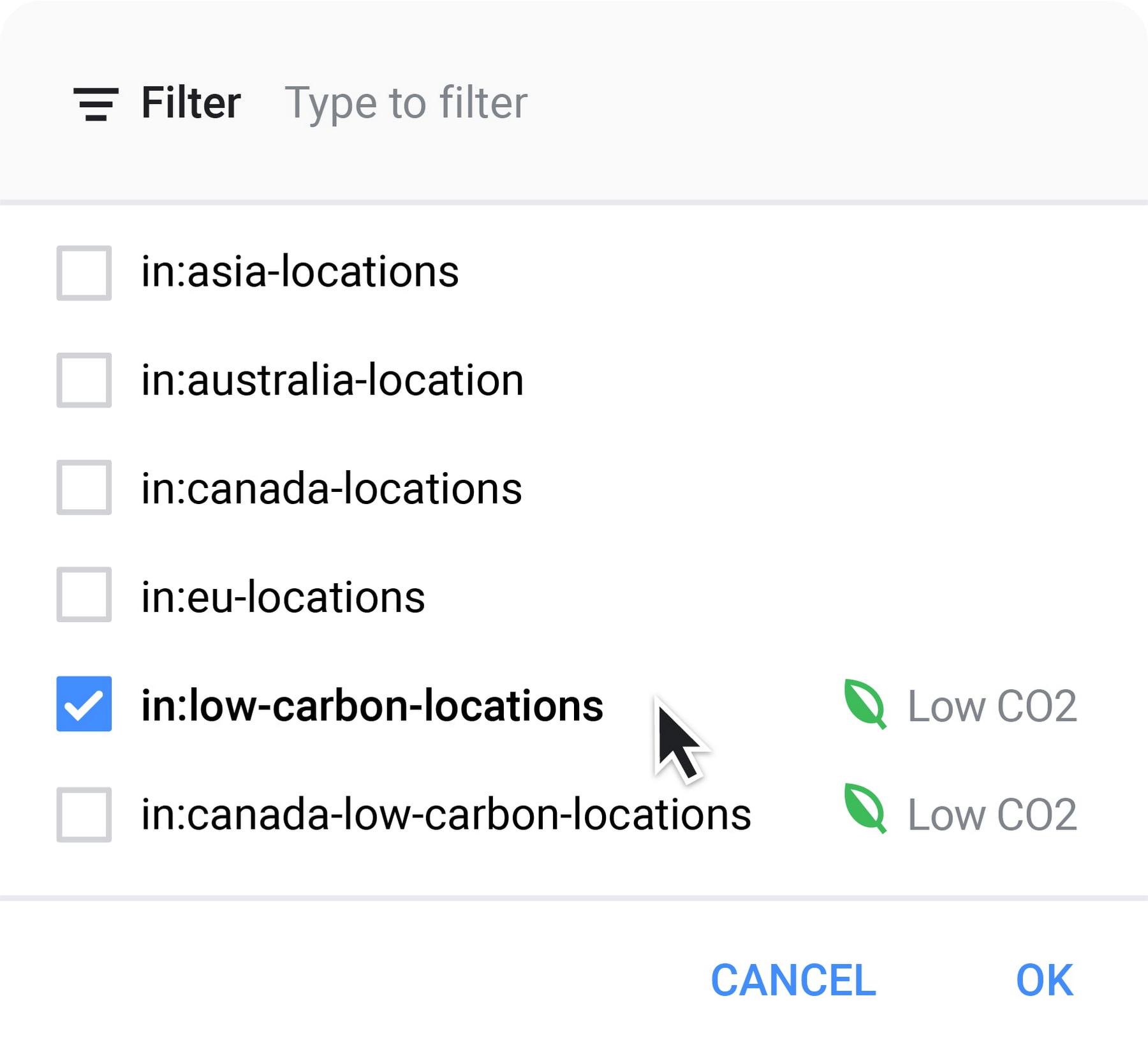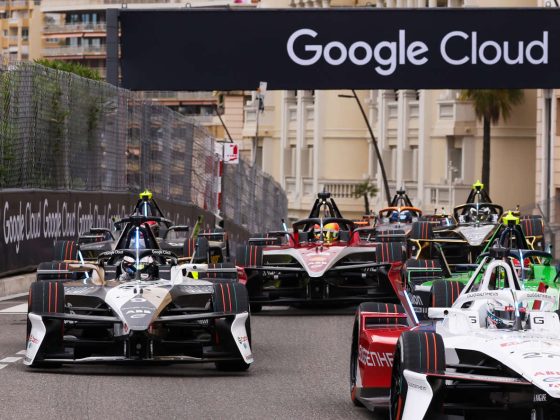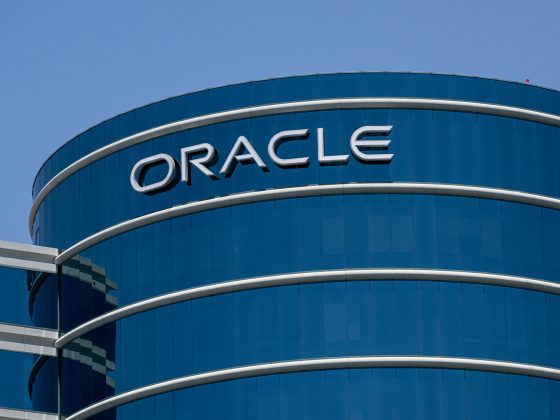At Google, we believe that the path to a sustainable future begins with the small decisions we make every day. But industries, governments and corporations are challenged to make these decisions without the right data or insights to inform them. Even a small choice for an organization — which raw material to choose for a new product, when to proactively water crops ahead of a drought, which green funds to invest in — requires understanding unique and often complex information.
Everyone wants to better understand how to become more sustainable, and take actions that have a meaningful impact. This year in the U.S., “how to reduce my carbon footprint” is being searched more than ever, and searches for “what is greenwashing” have increased five-fold over the past decade. Businesses and individuals alike are wondering how to turn sustainability ambition into action.
From our partners:
At the Google Cloud Sustainability Summit, we’re excited to expand our sustainability solutions, and launch new datasets, tools and partnership programs that can help make the sustainable choice the easy choice, for everyone.
Providing climate insights for every organization
Last week we announced two new climate insights offerings for the public sector to help institutions better understand the risks to infrastructure and natural resources due to climate change. These insights can help governments transform the way they manage physical and natural resources, helping them become more climate-resilient. Every industry is also experiencing a new era of sustainability-driven transformation. Like with any transformation, how, why and what you transform needs to be informed by accurate data about your current state, and insights into the potential impact of your decisions. To help deliver these insights to all our customers, we’re excited to share that Google Earth Engine on Google Cloud is now generally available.
Google Earth Engine, which originally launched to scientists and NGOs in 2010, is a leading technology for planetary-scale environmental monitoring. Google Earth Engine combines data from hundreds of satellites and other sources with geospatial cloud computing resources to show timely, accurate, high-resolution and decision-relevant insights about the state of the world’s habitats and ecosystems — and how they’re changing over time. With one of the largest publicly available data catalogs and a global data archive that goes back 50 years and updates every 15 minutes, it’s possible to detect trends and understand correlations between human activities and environmental impact more precisely than ever before.
With Google BigQuery, Google Maps Platform and Earth Engine, Google provides a powerful combination of geospatial cloud products and solutions to serve customers’ location-aware analysis needs regardless of the scale, complexity or format of the data. This will enable customers like Regrow, a startup in the field of regenerative agriculture, to more easily contribute to our shared challenges around climate change and tackle their unique business challenges involving geospatial data.
“Regrow aims to make regenerative agriculture ubiquitous across the globe with an overall mission to mitigate climate change. That job has been made easier by Google Earth Engine, a platform which has allowed us to scale our technology and increase confidence in our data and reports,” said Juan Delard de Rigoulieres Mantelli, CTO, Regrow
Sharing carbon-free energy insights with customers
When we set out to use 24/7 carbon-free energy across our global operations by 2030, we knew that we would need better tools to track energy consumption and production. After all, you can’t manage what you don’t measure, and existing approaches to clean energy tracking were not designed to track hour-by-hour energy use. For the past 10 years, and together with our partners, we’ve collected insights and knowledge about how to progress our business towards a carbon-free future. We’re excited to start sharing 24/7 carbon-free energy insights with our Google Cloud customers through a new pilot program.
With access to historical and real-time data, and at regional and hourly granularity, customers will see a clear picture of their electricity emissions profile. The pilot will enable customers to baseline their existing carbon-free energy (CFE) score and their scope 2 carbon footprint, help them forecast and plan for an optimized energy portfolio, and eventually execute on carbon-free energy transactions.
Sharing knowledge like this will be key to helping everyone reach ambitious net-zero targets. For example, companies like Iron Mountain are joining the Carbon-free Energy Compact to accelerate decarbonization.
“In 2021 we adopted the same 24/7 carbon-free energy goal pioneered by Google, and we recognize that the key to making progress towards this is access to good data and the ability to share that data with solution providers,” said Chris Pennington, Director of Energy and Sustainability at Iron Mountain. “Our early steps towards 24/7 have been enabled by key partners, including Google, who are providing us with the insights we need to evaluate our current performance and identify the next steps on our 24/7 journey. We place a great deal of value in collaboration to achieve better results, faster.”
Expanding the Carbon Sense suite
In the latest launch of the Carbon Sense suite of products we’re adding new data, expanding reporting coverage and making it easier for cloud architects and administrators to prioritize sustainability.
Last year we announced Carbon Footprint for Google Cloud, which helps companies measure, report and reduce the gross carbon emissions of using Google Cloud services. We’re excited that early next year, we’ll launch Carbon Footprint for Google Workspace, providing similar reporting functionality for the emissions associated with products like Gmail, Meet, Docs and others.
For sustainability teams that need to access the data in Carbon Footprint for reporting purposes, we’re also excited to launch a dedicated Identity and Access Management (IAM) role for Carbon Footprint. This will enable non-technical users of Google Cloud to easily access the emissions data and use it for tracking or in disclosures. You don’t need to be a cloud computing expert to view and export carbon emissions data associated with your cloud usage.
Shopify’s sustainability and IT teams are closely aligned on their sustainability goals. “Shopify is on a mission to be the lowest carbon commerce platform for millions of entrepreneurs around the world,” says Stacy Kauk, Head of Sustainability at Shopify. “Tools like Carbon Footprint allow our engineers to understand the carbon impact of our technology decisions, and ensure we continue to architect a fast, resilient and low-carbon commerce solution.”
You also don’t need to be a sustainability expert to make sustainable computing choices. For IT teams, and the administrators and cloud architects within them, we’re introducing low-carbon mode, which enables you to restrict your cloud resources to the low-carbon locations across our infrastructure using new low-carbon locations value groups. One of the most impactful actions you can take to reduce the gross emissions of using Google Cloud is to prioritize the locations with more carbon-free energy powering our infrastructure. Relative to other choices, you may be able to lower carbon emissions by 5-10x.
One company that is putting emissions data in the hands of engineers is Uber. “At Uber we take sustainability seriously across the organization,” said Michael Sudakovich, Sustainable Engineering Lead and Senior Security Engineer at Uber. “From giving riders more sustainable choices to now giving our engineers data about their services’ cloud emissions and recommendations on emission reduction, with Carbon Footprint. Helping everyone make more sustainable choices is a priority for all of our teams as we work to make Uber a zero-emission platform in Canada, Europe, and the US by 2030, and worldwide by 2040.”
Finally, Carbon Footprint is adding both scope 1 and 3 emissions to its reporting data. These are the apportioned amounts of Google’s scope 1 and 3 emissions, associated with a customers use of Google Cloud. You can read a detailed explanation of different scopes of emissions here, but for a quick breakdown: Scope 1 emissions are from sources an organization controls directly; Scope 2 are associated with the production of energy used by the organization (those were already in Carbon Footprint); and scope 3 are indirect emissions from up and down the value chain. Users will soon have a comprehensive view of the emissions associated with their Google Cloud usage.
“At SAP, sustainability is core to our culture and operations and we ensure it is infused across the organization. Our SAP Cloud deployment strategy focuses on sustainable data centers to help achieve our commitment to net-zero by 2030. We are leveraging Carbon Footprint to understand, report, and reduce our gross carbon emissions associated with our Google Cloud usage. Google data centers help SAP, and our joint customers, make their entire value chains more sustainable,” said Tom Lee, Head of Multicloud Products and Services, SAP.
Growing our sustainability ecosystem
The ecosystem of Google Cloud partners focused on sustainability continues to expand at a remarkable pace. The initiative, which brings technology providers together to help global businesses and governments accelerate sustainability programs, has added multiple new partners with innovative solutions. Today, we’re announcing two new programs to make it easier for partners to participate in the initiative, and for organizations to find the tools and expertise to help achieve their sustainability goals
First, Google Cloud Ready – Sustainability is a new validation program for partners with a business-ready solution available on Google Cloud that helps customers achieve sustainability goals. Partners with the GCR-Sustainability designation deliver solutions that reduce carbon emissions, increase the sustainability of value chains, help organizations process ESG data or help them identify climate risks for increased resilience.
Carto, Climate Engine, NGIS, GEOTAB, Planet, Atlas AI, Electricity Map have already achieved their Google Cloud Ready – Sustainability designation. Many of these partners have expertise in next-generation technologies addressing ESG challenges such as geospatial or climate data and analytics. Providers like Dun & Bradstreet are excited about this new sustainability validation program.
“As climate-related events increase in magnitude and frequency, it’s imperative that we incorporate climate data into business risk management across company locations and supply chains. Programs like Google Cloud Ready for Sustainability accelerate access to solutions that can drive ESG transformations, such as applying climate-based risk factors alongside traditional financial considerations,” said Rochelle March, Head of ESG Product at Dun & Bradstreet.
Cloud Ready for Sustainability is part of Google Cloud Partner Advantage, designed to maximize our partners’ success across business models, customer requirements, success metrics, and strategic priorities. You can learn more about Google Cloud Ready for Sustainability and complete an application here.
Second, we’re launching the Google Cloud Marketplace Sustainability Hub, providing customers with easy access to validated sustainability solutions. The Marketplace Sustainability Hub will showcase Google Cloud Ready for Sustainability solutions, which can be purchased directly from the site. Look for the Marketplace Sustainability Hub to launch soon.
Don’t miss all the exciting content at the Sustainability Summit
Tomorrow, June 28, we’re bringing technologists, developers, business and sustainability leaders together to learn how the climate leaders of today are building for the future. You can catch all the talks, films, presentations and demos here, so don’t miss out!
By: Justin Keeble (Managing Director of Global Sustainability, Google Cloud)
Source: Google Cloud Blog
For enquiries, product placements, sponsorships, and collaborations, connect with us at [email protected]. We'd love to hear from you!
Our humans need coffee too! Your support is highly appreciated, thank you!
